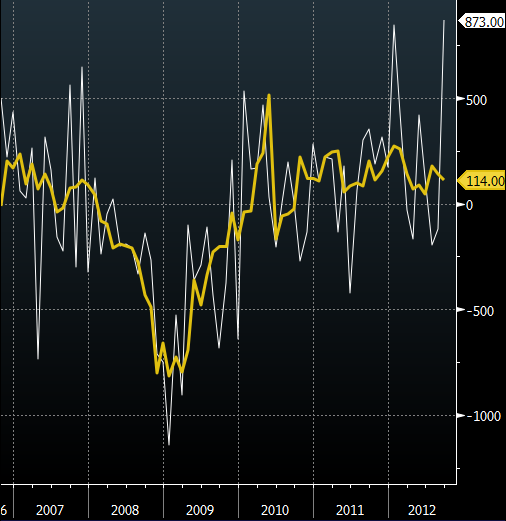This is a great piece examining all sides of employment numbers debate.
Trying to make sense of today's employment numbers
It is difficult to explain today's employment report from the Bureau of Labor Statistics. Back to school distortions, changes in temporary employment, and early harvest - all potentially distorted the results. Many of the numbers reported should be taken with a grain of salt. Here are some observations:
1. The headline unemployment number dropped to the lowest level since early 09 and was a complete surprise to the forecasters.
 |
| US headline unemployment rate (Bloomberg) |
2. In response, the Obama re-election odds on Intrade spiked, recovering some ground lost after the debates. Clearly the President's campaign strategists will use this to their advantage.
 |
| Source: Intrade |
The Fed will also likely use this result to claim that it is the result of the central bank's expansionary policy.
3. It's unclear however where this sudden improvement in the unemployment rate came from. In the past big declines were the result of decreasing labor participation. But the Employment to Population ratio actually ticked up this month.
4. Some are pointing to the big spike in US Employment Total in Labor Force of 873K as an explanation for this decline in the unemployment rate. But that number is notoriously volatile and difficult to adjust for back to school seasonality. The chart below compares the US Employment Total in Labor Force survey (white) with the non-farm payroll changes (yellow). The survey has basically fluctuated - sometimes wildly - around the payrolls data, but on average followed payrolls closely. And payrolls growth continues to be anemic - certainly not enough to explain the drop in the unemployment rate.
 |
| US Employment Total in Labor Force survey (white) vs. non-farm payrolls (yellow) |
5. Part-time jobs classified as "for non-economic reasons" have declined by 260K while we saw a 582K jump in part-time employment for "economic reasons" (defined as "those who worked 1 to 34 hours during the reference week for an economic reason such as slack work or unfavorable business conditions, inability to find full-time work, or seasonal declines in demand"). It seems this may be part of the explanation for the lower unemployment rate, though it does not bode well for the US labor markets.
 |
| Part-time payrolls for "economic" (white) vs. "non-economic" reasons (yellow). |
6. There may be another factor at work. Because of the severe summer drought, many crops had to be harvested early and quickly (since crops matured early) - with a big percentage of them used to make feed. There is anecdotal evidence that many who take farm work on a part-time/temp basis have seen heavier workloads on the farm, which would normally show up in government statistics later in the year. Some people therefore no longer show up in the unemployment number, yet the farm payrolls are not included in September's non-farm payroll report. Harvesting will be completed by Halloween rather than Thanksgiving this year, making seasonal adjustments for this shift between farm and non-farm demand more difficult. Of course this effect will be reversed later in the year.
7. And of course some high profile commentators are saying the numbers were simply cooked.

No comments:
Post a Comment